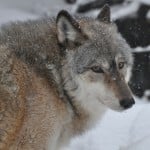Boltz – Opportunistic Carnivores
Biologists will often describe wolves as opportunistic carnivores. This generally relates to their hunting behavior, rather than fitting into a defined prey selection method, wolves tend to look for opportunities for the easiest prey. In captivity, where hunting for prey is restricted to the stray squirrel or songbird, there seems to be some transfer of predatory behaviors to fellow pack members. This can start out as social behavior, stalking and ambushing another pack member, leading to a chase around the enclosure with tails wagging. In the case of some dominance behavior, this can also be observed with younger wolves, watching an older pack leader for vulnerability. We typically see this when our dominant pack leaders are between 8 – 10 years of age, and our subordinate pack members are in the 2 – 4 year range. As we enter the year 2016, we have entered the time where older wolves have weaknesses and opportunistic young adults are quick to respond. As we look at Boltz’s gaze and head posture, it suggests a wolf looking for opportunities.




